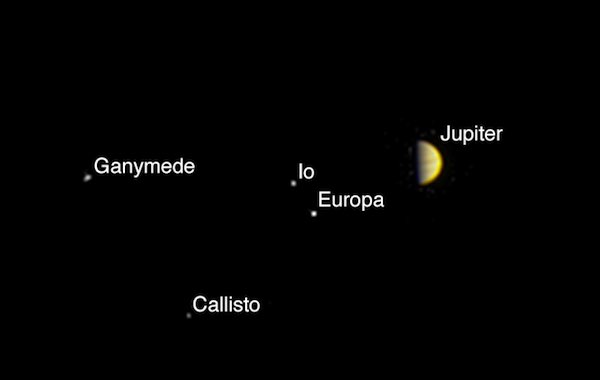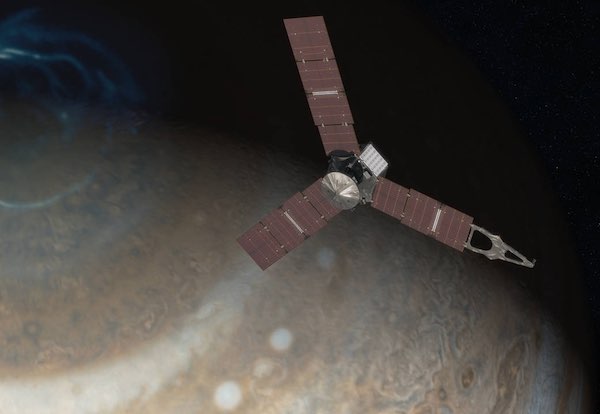Jovian fireworks: Juno arrives at Jupiterby Jeff Foust
|
| “One of the primary goals of Juno is to learn the recipe for solar systems. How do you make the solar system? How do you make the planets in the solar system?” said Bolton. |
Juno is the latest NASA mission to celebrate the Fourth of July in a unique way. On the evening of July 4, Juno will fire its main thruster for 35 minutes, slowing the spacecraft down enough to enter into an initial orbit around Jupiter, making it only the second spacecraft, after Galileo, to orbit the solar system’s largest planet. A second, shorter burn in October will put the spacecraft into its desired science orbit, a 14-day polar orbit.
Yet, with just a week before its arrival, Juno has not attracted the attention of many other missions. Last year at this time, the publicity machine was already in high gear for the upcoming Pluto flyby by New Horizons (which, like Juno, is a New Frontiers medium-class planetary science mission.) Juno, by comparison, has received far less attention. Of course, New Horizons was the first mission to Pluto, while Juno is only the latest in a series of missions to Jupiter dating back to the 1970s. Been there, done that?
Project scientists don’t think so, arguing that the $1.1-billion mission will address scientific questions as large as the planet the spacecraft will soon be orbiting. “One of the primary goals of Juno is to learn the recipe for solar systems. How do you make the solar system? How do you make the planets in the solar system?” said Scott Bolton, the Southwest Research Institute scientist who is the principal investigator on the Juno mission, during a June 16 press conference at NASA Headquarters.
Juno can help answer those questions, he said, because scientists believe it was the first planet to form in our solar system. For example, one key question is what kind of core Jupiter has. “If there is a core of heavy elements—a bunch of rocky, icy material squeezed down in the center of Jupiter—it tells us something about the early processes in the solar system,” he said, “because that means the rocks must have formed in the early solar system, before Jupiter did.”
If there some kind of core like that, he concluded, “it tells you sort of when, and how, and a little bit of where, Jupiter must have formed.”
Another key area of investigation will be the planet’s powerful magnetic field. Juno’s polar orbit gives it an ideal vantage point to study Jupiter’s aurorae, Bolton said. “These are the strongest auroral emissions in the entire solar system,” he said. “Jupiter is a planet on steroids. Everything about it is extreme.”
| “Jupiter has the scariest radiation environment of any planet in the solar system,” said Becker. |
Juno will carry out those investigations with a suite of instruments. A microwave radiometer will probe hundreds of kilometers below the planet’s cloudtops to measure the abundance of water, another key factor in how the planet formed. A gravity science instrument will help reveal the planet’s interior structure. Several other instruments will measure the planet’s magnetic field, charged particle environment, and aurorae. (That includes the winner of the most creative instrument acronym, the Jupiter Energetic-particle Detector Instrument, or JEDI.)
Juno is not primarily an imaging mission, but it does carry a visible light camera known as JunoCam, based on a design used for a descent imager used to document the landing of the Curiosity Mars rover. That camera is not officially considered a science instrument—it was added primarily for public engagement, given the belief that a spacecraft that doesn’t take pretty pictures will be boring to the general public—but will provide the first views of Jupiter’s poles.
 An image of Jupiter and its four large Galilean moons taken by Juno’s JunoCam camera on June 21. (credit: NASA/JPL-Caltech/SwRI/MSSS) |
But the mission’s unusual design carries with it some risks. Its elliptical orbit takes it to within a few thousand kilometers of Jupiter’s cloudtops on closest approach. That exposes the spacecraft and its instruments to a harsh radiation environment created by charged particles accelerated by the planet’s magnetosphere that affects every aspect of the spacecraft’s design.
“Scott and the science team asked us to take a spacecraft where no spacecraft has ever gone before: deep into the harshest radiation environment, the most treacherous radiation environment in the solar system aside from the Sun,” said Rick Nybakken, Juno project manager at JPL.
“Jupiter has the scariest radiation environment of any planet in the solar system,” said Heidi Becker, radiation monitoring investigation lead for the mission at JPL. Those charged particles, accelerated to near the speed of light, “are incredibly penetrating, they’re damaging to electronics, and they can create enough noise in a detector to totally blind a camera.”
The spacecraft’s key components are protected from that harsh environment by a “radiation vault,” a titanium box with walls more than a centimeter thick. “It’s enough to bring down the radiation environment by about a factor of 800,” she said. Instruments located outside of the box have their own “bulletproof vests” to provide radiation exposure, such a star tracker embedded within a box that provides more shielding than any other part of the spacecraft, and for good reason. “Without that extra protection, we wouldn’t be able to navigate Juno.”
Juno and its instruments will still suffer the effects of radiation. Becker said that the team will measure the noise in the star tracker as one way to calculate the spacecraft’s radiation exposure. And the project expects that JunoCam will suffer enough damage to shut down at some point before the end of the mission, although they expect it to last for at least seven orbits.
Before scientists worry about the long-term effects of radiation exposure on the spacecraft, they first have to get it through the July 4 maneuver that captures the spacecraft into orbit. That maneuver has to work correctly, and do so in that radiation environment project officials acknowledge they don’t fully understand.
And, given the distance of Juno from the Earth, the spacecraft will be on its own. “We’ve got 48 minutes one-way light time,” said Jeff Lewis, Juno spacecraft engineer at spacecraft developer Lockheed Martin, in an interview last month. “You really have to design the spacecraft to be autonomous and take care of itself.”
That’s especially critical during Jupiter orbit insertion, or JOI. If radiation caused the spacecraft’s processor to spontaneously reboot, he said, the spacecraft is designed to pick up where it left off and resume the engine burn, keeping track of how much more change in velocity it needs to achieve orbit.
In the weeks leading up to the encounter, the spacecraft team has been going through a series of dress rehearsals for JOI and the later October maneuver, Lewis said. That included “wall clock” rehearsals that take place at the same time of day, and at the same pace, as the actual encounter. There have also been a series of reviews to verify the team is ready for JOI.
| “Somebody asked, ‘When does the nail biting start?’ It’s already started,” Bolton said. |
Preparations for JOI began a week ago, with the opening of the main engine cover and enabling its auto restart capability. Four days before JOI, Juno will start running its command sequence for the encounter, with a series of preparations ramping up in the two hours before the engine burn begins. The spacecraft’s science instruments will also be turned off during the maneuver.
“The part we’re going to be watching most intensely will be the main engine burn itself,” Nybakken said. “I can tell you that when that completes, you’re going to see a lot of celebration because that means we’ll be in orbit around Jupiter. That’ll be really cool.”
The spacecraft can still go into orbit if the engine burns for as little as 20 minutes, he said, although he added he expects the computer safeguards, like the auto restart of the main computer, to still allow for a full engine burn. “Most likely, we expect to get all the way to 35 minutes.”
And what if the engine doesn’t burn at all? “We don’t end up in a very exciting spot,” he said. The spacecraft would get a “nice deflection” from Jupiter’s gravity as it flew by the planet, but Nybakken said the team hasn’t studied that contingency very much.
The mission is confident that contingency won’t happen. Lewis noted that the engine has already fired twice during earlier phases of the mission, and the propulsion system is “flushed” once a year to ensure it’s working properly.
That doesn’t mean there isn’t any nervousness on the Juno team, given there’s only one opportunity to enter orbit. “Somebody asked, ‘When does the nail biting start?’ It’s already started,” Bolton said. “There’s a mix of excitement and anticipation with tension and anxiety, and I felt the exact same thing on the day of launch.”
But if all goes well on July 4, and the later October burn, the spacecraft will operate for more than a year to collect data that project scientists hope will help answer those questions about the formation of the planet and the solar system. Juno’s mission will conclude in February 2018, with a planned entry into Jupiter’s atmosphere to avoid the risk of the spacecraft colliding with one of the planet’s potentially habitable moons.
That entry will be the real fireworks of the mission. On July 4, scientists and engineers will be happy for a lack of fireworks, hoping Juno carries out its thruster burn as planned as it plunges into the hazardous radiation environment surrounding Jupiter.
